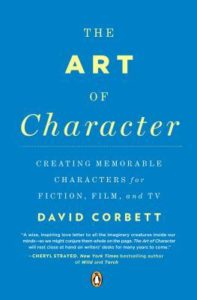 There’s no denying today’s fiction in any medium is character driven. The people that inhabit our fictional worlds must be relatable and compelling enough to allow the story to come to life. Yet, characterization is as complex as we are, covering a vast range of emotions and psychological factors with infinite degrees of latitude, not to mention physical elements that can influence hearts and minds in ways we often cannot comprehend. The people in our fiction are typically not real at all, and it’s impossible to convey reality on the page, or the screen. David Corbett’s The Art of Character: Creating Memorable Characters for Fiction, Film, and TV offers an in-depth and comprehensive method for creating characters to drive our stories that goes far beyond character sheets and general stats.
There’s no denying today’s fiction in any medium is character driven. The people that inhabit our fictional worlds must be relatable and compelling enough to allow the story to come to life. Yet, characterization is as complex as we are, covering a vast range of emotions and psychological factors with infinite degrees of latitude, not to mention physical elements that can influence hearts and minds in ways we often cannot comprehend. The people in our fiction are typically not real at all, and it’s impossible to convey reality on the page, or the screen. David Corbett’s The Art of Character: Creating Memorable Characters for Fiction, Film, and TV offers an in-depth and comprehensive method for creating characters to drive our stories that goes far beyond character sheets and general stats.
Corbett’s credits are numerous, with several novels and collections to his name, as well as his tenure with Writer’s Digest as a contributing editor. He certainly knows what he’s talking about with characterization. The book is broken down into four parts: Conceiving the Character, which focuses on determining whether characters are created for our stories or discovered first, our source materials for characters, and using personal experience to hone in on a character; Developing the Character, covering dramatic characterization, character desire and how desire affects goals, and how denial of desire affects how characters maneuver and navigate among the other characters, character vulnerability, the secrets we keep and how that affects characters, how characters are contradictory, using scenes to create a biography of your characters, the physical nature of your characters, as well as their psychological make-up and how they fit into society and politics, even bad habits and quirks; Roles, which dives down into choosing your protagonist, framing the conflict, how change affects your character, your characters’ internal struggles, dealing with conflict with an opponent, and secondary characters; finally Technique, which shows you ways to use scenes to balance action and inner life, using point-of-view to your advantage and when you may consider changing it, character voice, and dialogue. Each part is broken into chapters which tackles each of these subjects in a way that’s easy to read and understand.
 A compelling and relatable character will never be a Band-Aid for shoddy story engineering; characterization is just as important as the story, and when these two elements meet in full synchronicity, the results are worth the time and effort. Readers need an anchor to guide them, and Corbett’s method goes deep enough into characterization to give you the tools to create characters your readers won’t soon forget. As you can see from the part and chapter breakdown above, Corbett covers all the bases. Even if you only use 20% of the information in this book, there’s no doubt you’ll find ways to improve your characterization. Readers of today want characters that feel alive, and with these tools under your belt, they might just believe it.
A compelling and relatable character will never be a Band-Aid for shoddy story engineering; characterization is just as important as the story, and when these two elements meet in full synchronicity, the results are worth the time and effort. Readers need an anchor to guide them, and Corbett’s method goes deep enough into characterization to give you the tools to create characters your readers won’t soon forget. As you can see from the part and chapter breakdown above, Corbett covers all the bases. Even if you only use 20% of the information in this book, there’s no doubt you’ll find ways to improve your characterization. Readers of today want characters that feel alive, and with these tools under your belt, they might just believe it.
BOB PASTORELLA
If you enjoyed our Searchlight profile of The Art of Character: Creating Memorable Characters for Fiction, Film, and TV by David Corbett, please consider clicking through to our Amazon affiliated links. If you do you’ll keep the This is Horror ship afloat with some very welcome remuneration.
Buy The Art of Character: Creating Memorable Characters for Fiction, Film, and TV by David Corbett









